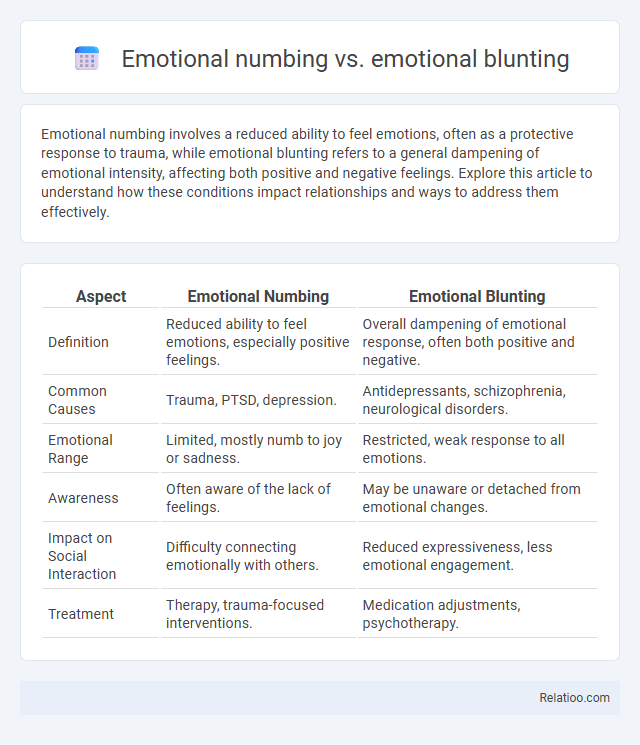Emotional numbing involves a reduced ability to feel emotions, often as a protective response to trauma, while emotional blunting refers to a general dampening of emotional intensity, affecting both positive and negative feelings. Explore this article to understand how these conditions impact relationships and ways to address them effectively.
Table of Comparison
| Aspect | Emotional Numbing | Emotional Blunting |
|---|---|---|
| Definition | Reduced ability to feel emotions, especially positive feelings. | Overall dampening of emotional response, often both positive and negative. |
| Common Causes | Trauma, PTSD, depression. | Antidepressants, schizophrenia, neurological disorders. |
| Emotional Range | Limited, mostly numb to joy or sadness. | Restricted, weak response to all emotions. |
| Awareness | Often aware of the lack of feelings. | May be unaware or detached from emotional changes. |
| Impact on Social Interaction | Difficulty connecting emotionally with others. | Reduced expressiveness, less emotional engagement. |
| Treatment | Therapy, trauma-focused interventions. | Medication adjustments, psychotherapy. |
Understanding Emotional Numbing and Emotional Blunting
Emotional numbing and emotional blunting are psychological responses that reduce the intensity of your emotional experiences, often as a coping mechanism against trauma or chronic stress. Emotional numbing specifically refers to a complete or profound absence of emotional response, while emotional blunting involves a diminished or muted emotional expression without the total loss of feeling. Understanding these distinctions helps in recognizing symptoms and seeking appropriate mental health support to restore emotional balance.
Key Differences Between Emotional Numbing and Blunting
Emotional numbing involves a reduced ability to feel emotions, often as a protective response to trauma or severe stress, whereas emotional blunting refers to a more general and persistent dampening of emotional intensity regardless of specific triggers. You may notice emotional numbing affects only certain feelings or situations, while emotional blunting creates a broader sense of emotional flatness across daily life. The key difference lies in the selective, situational nature of numbing versus the pervasive, ongoing reduction characteristic of blunting.
Common Causes of Emotional Numbing
Emotional numbing and emotional blunting both describe reduced emotional responsiveness, with emotional numbing often linked to trauma or PTSD, while emotional blunting relates more to depression or medication side effects. Common causes of emotional numbing include chronic stress, unresolved trauma, anxiety disorders, and certain neurochemical imbalances that dull your ability to feel emotions deeply. Identifying these causes is crucial for developing effective strategies to regain emotional sensitivity and improve mental well-being.
Common Causes of Emotional Blunting
Emotional blunting, often confused with emotional numbing, refers to a reduced ability to feel emotions intensely, while emotional numbing specifically describes a detachment from emotional experiences following trauma or stress. Common causes of emotional blunting include prolonged use of antidepressants, chronic stress, depression, and certain neurological conditions. Understanding these factors helps you recognize emotional blunting and seek appropriate treatment to restore emotional responsiveness.
How Emotional Numbing Manifests in Daily Life
Emotional numbing manifests as a diminished ability to feel emotions, often causing Your responses to everyday experiences to seem flat or detached, impacting relationships and decision-making. Unlike emotional blunting, which involves a general reduction in emotional intensity, emotional numbing specifically reduces the emotional range due to trauma or stress. This condition can lead to difficulties in recognizing or expressing feelings, resulting in social withdrawal and impaired emotional connection.
Signs and Symptoms of Emotional Blunting
Emotional blunting presents as a marked reduction in the intensity of emotional responses, where individuals often feel detached or indifferent to situations that would typically evoke strong feelings. Common signs include a diminished ability to experience joy, sadness, or anger, and a lack of motivation or interest in social interactions and activities once enjoyed. This condition differs from emotional numbing, which is often characterized by an absence of feelings related to traumatic events, whereas emotional blunting affects overall emotional processing and responsiveness.
Impact on Relationships and Social Connections
Emotional numbing, emotional blunting, and emotional detachment each affect Your relationships and social connections differently but significantly, often leading to reduced empathy, decreased emotional responsiveness, and challenges in forming or maintaining intimacy. Emotional numbing typically results in an inability to feel positive or negative emotions, creating distance from loved ones and impairing communication. Emotional blunting refers more to a general dulling of emotional intensity, which can cause others to perceive You as indifferent or disengaged, while emotional detachment often leads to purposeful withdrawal from social interactions, further isolating You from meaningful connections.
Emotional Numbing and Mental Health Disorders
Emotional numbing, a key symptom in post-traumatic stress disorder (PTSD) and depression, involves a reduced capacity to experience feelings, leading to detachment and difficulty connecting with others. Emotional blunting, often associated with medication side effects, especially antidepressants and antipsychotics, results in a diminished emotional response but differs by typically not involving the profound disconnection seen in emotional numbing. Understanding emotional numbing's role in mental health disorders is crucial for accurate diagnosis and targeted therapeutic interventions, as it significantly impairs emotional processing and social functioning.
Treatment Approaches for Numbing vs Blunting
Treatment approaches for emotional numbing often involve trauma-focused therapies such as Cognitive Behavioral Therapy (CBT) and Eye Movement Desensitization and Reprocessing (EMDR) to address underlying post-traumatic stress and restore emotional responsiveness. Emotional blunting, commonly linked with antidepressant use or neurological conditions, may require medication adjustments coupled with psychotherapeutic interventions like Acceptance and Commitment Therapy (ACT) to enhance emotional awareness and processing. Differentiating between emotional numbing and blunting is crucial, as tailored strategies targeting the root causes--whether trauma-related or pharmacological--optimize recovery outcomes.
When to Seek Professional Help
Emotional numbing involves a diminished ability to experience feelings, often linked to trauma or PTSD, while emotional blunting is characterized by reduced emotional responsiveness, sometimes a side effect of medication or depression. You should seek professional help if these symptoms interfere with daily functioning, relationships, or cause distress. Timely intervention by mental health professionals can provide effective strategies and treatments tailored to your specific needs.

Infographic: Emotional numbing vs emotional blunting
 relatioo.com
relatioo.com